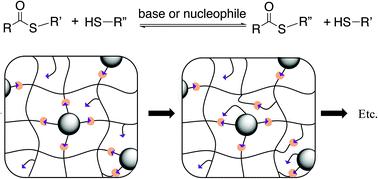当前位置:
X-MOL 学术
›
Polym. Chem.
›
论文详情
Our official English website, www.x-mol.net, welcomes your feedback! (Note: you will need to create a separate account there.)
Enhancing the toughness of composites via dynamic thiol–thioester exchange (TTE) at the resin–filler interface
Polymer Chemistry ( IF 4.6 ) Pub Date : 2020-06-08 , DOI: 10.1039/d0py00563k Nancy Sowan 1, 2, 3, 4 , Yinan Lu 2, 3, 4, 5 , Kevin J. Kolb 1, 2, 3, 4 , Lewis M. Cox 4, 6, 7, 8 , Rong Long 2, 3, 4, 5 , Christopher N. Bowman 1, 2, 3, 4, 9
Polymer Chemistry ( IF 4.6 ) Pub Date : 2020-06-08 , DOI: 10.1039/d0py00563k Nancy Sowan 1, 2, 3, 4 , Yinan Lu 2, 3, 4, 5 , Kevin J. Kolb 1, 2, 3, 4 , Lewis M. Cox 4, 6, 7, 8 , Rong Long 2, 3, 4, 5 , Christopher N. Bowman 1, 2, 3, 4, 9
Affiliation

|
Due to a mismatch in mechanical moduli, the interface between constituent materials in a composite is the primary locus for crack nucleation due to stress concentration. Relaxation of interfacial stresses, without modifying the properties of constituent materials, is a potent means of improving composite performance with broad appeal. Herein, we develop a new type of adaptive interface that utilizes thiol–thioester exchange (TTE) at the filler–polymer interface. Specifically, dynamic covalent bonds sequestered at material interfaces are reversibly exchanged in the presence of thioester moieties, excess thiol and a base/nucleophile catalyst. Employing this active interface effectively mitigates deleterious growth of interfacial stresses, thereby enhancing the composite's mechanical performance in terms of reductions in polymerization shrinkage stress and improvement in toughness. Activating interfacial TTE in an otherwise static matrix resulted in 45% reduction in the polymerization stress, more significant post-polymerization stress relaxation and drastically increased toughness relative to control composites incapable of TTE bond exchange but otherwise identical. In particular, the higher fracture toughness in TTE-activated composites is attributed to the alleviation of crack tip strain concentration, as revealed by digital image correlation.
中文翻译:

通过树脂-填料界面处的动态硫醇-硫酯交换(TTE)增强复合材料的韧性
由于机械模量不匹配,复合材料中组成材料之间的界面是应力集中导致裂纹成核的主要场所。在不改变组成材料性能的情况下,缓和界面应力是提高复合材料性能并具有广泛吸引力的有效手段。本文中,我们开发了一种新型的自适应界面,该界面在填料-聚合物界面处利用了巯基-硫酯交换(TTE)。具体而言,在硫酯部分,过量硫醇和碱/亲核催化剂的存在下,隔离在材料界面上的动态共价键可逆地交换。使用此主动界面可以有效地减轻界面应力的有害增长,从而增强复合材料的抗压强度。降低聚合收缩应力和提高韧性方面的机械性能。与不能进行TTE键交换但其他方面相同的对照复合材料相比,在其他情况下为静态的基质中活化界面TTE可使聚合应力降低45%,聚合后应力松弛更为明显,并且韧性大大提高。尤其是,TTE活化复合材料的较高断裂韧性归因于裂纹尖端应变浓度的降低,如数字图像相关性所揭示的。相对于不能进行TTE键交换但其他方面相同的对照复合材料,聚合后应力松弛更显着,韧性大大提高。尤其是,TTE活化复合材料的较高断裂韧性归因于裂纹尖端应变浓度的降低,如数字图像相关性所揭示的。相对于不能进行TTE键交换但其他方面相同的对照复合材料,聚合后应力松弛更显着,韧性大大提高。尤其是,TTE活化复合材料的较高断裂韧性归因于裂纹尖端应变浓度的降低,如数字图像相关性所揭示的。
更新日期:2020-07-28
中文翻译:

通过树脂-填料界面处的动态硫醇-硫酯交换(TTE)增强复合材料的韧性
由于机械模量不匹配,复合材料中组成材料之间的界面是应力集中导致裂纹成核的主要场所。在不改变组成材料性能的情况下,缓和界面应力是提高复合材料性能并具有广泛吸引力的有效手段。本文中,我们开发了一种新型的自适应界面,该界面在填料-聚合物界面处利用了巯基-硫酯交换(TTE)。具体而言,在硫酯部分,过量硫醇和碱/亲核催化剂的存在下,隔离在材料界面上的动态共价键可逆地交换。使用此主动界面可以有效地减轻界面应力的有害增长,从而增强复合材料的抗压强度。降低聚合收缩应力和提高韧性方面的机械性能。与不能进行TTE键交换但其他方面相同的对照复合材料相比,在其他情况下为静态的基质中活化界面TTE可使聚合应力降低45%,聚合后应力松弛更为明显,并且韧性大大提高。尤其是,TTE活化复合材料的较高断裂韧性归因于裂纹尖端应变浓度的降低,如数字图像相关性所揭示的。相对于不能进行TTE键交换但其他方面相同的对照复合材料,聚合后应力松弛更显着,韧性大大提高。尤其是,TTE活化复合材料的较高断裂韧性归因于裂纹尖端应变浓度的降低,如数字图像相关性所揭示的。相对于不能进行TTE键交换但其他方面相同的对照复合材料,聚合后应力松弛更显着,韧性大大提高。尤其是,TTE活化复合材料的较高断裂韧性归因于裂纹尖端应变浓度的降低,如数字图像相关性所揭示的。


























 京公网安备 11010802027423号
京公网安备 11010802027423号